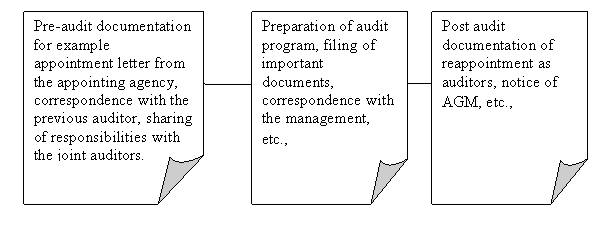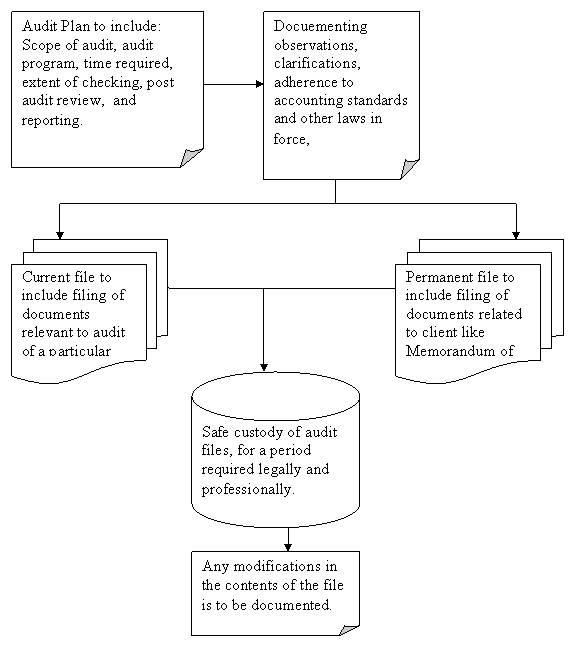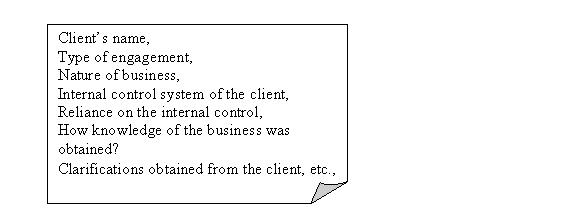Audit Documentation
[Submitted by Mr .Aditya Kumar S.,
CA(Final) student,
Bangalore]
April 12, 2007
"The skill of an accountant can always be ascertained by an inspection of his working papers." Robert H. Montgomery, Montgomery's Auditing, 1912.
During the performance of an audit, it is obvious that the auditor may have come across issues which were a subject matter of discussion with the management, an expert's opinion had to be called for or a reservation was expressed by either the management or the auditor on treatment of a particular transaction.
It ultimately boils down to what was the final conclusion and how was it treated in the financial statements?
It is imperative for the auditor to design audit plan in such a manner that the audit procedures brings into light all material and relevant factors that go in as part of the audit and finally finds its place in the Audit Report.
The first aid of defense is the documentation of audit plans, which is transparent enough to prove that audit was conducted in adherence to the standards. So, what is documentation?
Documentation refers to the working papers prepared and obtained by the auditor and retained by him in connection with performance of an audit.
International Standard on Auditing - 230 (Revised) defines Audit Documentation as: "Audit documentation" means the record of audit procedures performed, relevant audit evidence obtained, and conclusions the auditor reached.
Further, the Australian Standard on Auditing - 208 also includes, the documents stored in electronic media.
So, when should the auditor prepare the documents?
The entire process of documentation can be expressed diagrammatically as follows:

After the audit report is issued, there may be circumstances wherein questions can be raised on the financial statements of the organization, or the integrity of the auditor might itself by challenged.
The importance of audit documentation is well known in the case of Enron. The case against Andersen for its audit of Enron was focused on the destruction of documents. What were these documents? These documents were pertaining to the audit of the client i.e., the working papers. Proper audit documentation will aid the auditor in defending the case.
So how does documentation of audit work help an auditor? The audit documents prove the following:
- The fact that audit was carried out in tune with the scope,
- The objective of the audit was attained,
- The audit was planned and systematic,
- All Auditing and Assurance Standards applicable were adhered to,
- To aid the auditor in peer review,
- To aid legal and professional requirements,

Reporting on True and fairness of the financial statements:
The primary question that arises is how does the auditor satisfy himself about the truth and fairness of the financial statements, or rather going down to the level of transaction itself? It is with the help of vouchers, supporting bills, correspondence with external and internal parties, expert opinions, etc., all these act as evidence for the assertions made by the management. If the auditor is satisfied with the evidence presented, he vouches for the genuineness of the transaction. All these evidences, in turn help the auditor to form an opinion on the financial statements.
Relying on Management Representations:
Transactions like choosing accounting policies, classification of investments, and provision for bad and doubtful debts wherein the judgment of the management is required, management letters are prepared and presented to the auditors. These management letters acts as useful evidence for events which forms part of the audit report.
Does audit assure the readers the financial health of the entity?
Let us remember that audit report does not give assurance of the financial statements, it is an expression of opinion by an expert. Therefore, no audit is free from risk of material misstatement, detection of any error or frauds, etc., So, in this scenario, it is the duty of the auditor to detect such risks and take steps (by increasing the checking percentage or look for alternative evidences) to mitigate such risks. All the actions of the auditor taken to reduce risks is to be documented, indicating that the risks were indeed identified, quantified and appropriate action was taken to mitigate the risk.
Co-ordination with other auditors:
Welcome, to the age of big corporate. It is now not possible for any one auditor to audit and report on the accounts of huge corporate house, because of the sheer size and complexity of the business. Therefore, more than one auditor is appointed. Unless there is division of work, the joint auditors would trespass their respective areas and audit is hampered. Documenting the do's and don'ts of each other would make sure that the audit is properly planned and executed.
Extent of documentation:
Another question that arises in the mind of all the readers, is it required for the auditor to document all the evidences procured during the process of audit? No. It depends on the gravity of the transaction and its importance for the reader of the financial statements. This is called as materiality. What is material and what is immaterial is judgmental? It is left to the wisdom of the auditor to decide from time to time and in certain circumstances to decide what is material and immaterial. How has the auditor arrived at such a conclusion is required in forming the audit report? Documentation is required to prove the procedures taken to arrive at such conclusion.
Extent of test checking to form an opinion:
It is not possible to cover all the transactions under audit. A random sample is taken out of a population. And such samples are taken on some basis or on some judgment. This is to be recorded, to ensure there is consistency in applying the formula, unless circumstances call for a differentiated approach. Or, to ensure that the formula used to collect the sample was right or wrong, the sample has to be recorded.
Quality of the Audit:
The quality of the audit would be reflected in the acceptance of the audit report by the stakeholders. To maintain the quality of the work, certain procedures have to be reworked on a continuous basis and have to be modified to suit the changing environment. To keep track of the quality of the work done, it is imperative to record the procedures of work done and compare them over a period of time.
Applicability of Laws:
Another issue which is of prime importance is applicability of law and its implementation by the client. An auditor is not an expert in law. How can he be sure that the client is a law abiding citizen? If there is any contravention of law, the client could face both economic and goodwill loss in the market. So, a legal opinion has to be considered to be sure about the legal status of the client. Therefore, he has to document or record the implications in consultation with the client and legal expert before reporting.
The auditor should be sure about the scope of the audit lest his services would be of little use. To understand and confirm the scope of the audit, it is necessary that the scope is mentioned in detail in the engagement letter. Engagement letter once documented and confirmed by the client, casts a duty upon the auditor to work within such scope and the client is also sure about the responsibility of the auditor. Unless, the scope is determined it is not possible for the auditor perform his duties?
Transparency is the key word in documentation. Internal Auditing Standard requires:
The auditor should prepare the audit documentation so as to enable an experienced auditor, having no previous connection with the audit, to understand:
- The nature, timing, and extent of the audit procedures performed to comply with ISAs and applicable legal and regulatory requirements,
- The results of the audit procedures and the audit evidence obtained; and
- Significant matters arising during the audit and the conclusions reached thereon.
The form and content of the documentation depends on:
- Nature of the audit,
- Audit procedures intended to be carried out,
- Audit evidences to be collected,
- Significance of such evidences,
- Audit methodology and tools used.
Working papers are the most crucial part of documentation. So, is there any prescribed format of working papers? NO. It is again a judgment an auditor has to make. However, the working papers should be designed such that a new auditor with no previous experience of the audit should be able to review the audit work done and should come to a conclusion that yes, the audit was done based on some standards.
Some countries have prescribed minimum period of 5-6 years retention of the documents, but again it is very subjective. International Auditing Standards require the documents be assembled or stored in the audit engagement file within 60 days from the date of audit report.
Working papers should state:

So, whatever be the document and it's classification it should adhere to the principles of auditing and should be an aid to the auditor in forming a report. It is the duty of the auditor to retain the custody of the working papers as required legally and professionally. Remember, the working papers are the property of the auditor and it's safe custody is in the hands of the auditor. Any change or modification in the file or the contents of the documents can be done but keeping in view the implications on the audit conclusions arrived at and professional ethics. Further, the auditor should document under what circumstances such modification in the contents were made, person responsible for such a alteration, and whether any review was conducted again to retain the transparency of the documentation procedures.
Bibliography
1. www.icai.org
2. AAS issued by the ICAI,
3. www.aarf.asn.au
4. www.ifac.org
5. www.apb.org
6. www.nysscpa.org
7. CPA Journal June 2005
8. AICPA Peer Review Guide
9. "The New Audit Documentation Requirements" by Ray Whittington and Gretchen Fischbach in AICPA's Journal of Accountancy.

